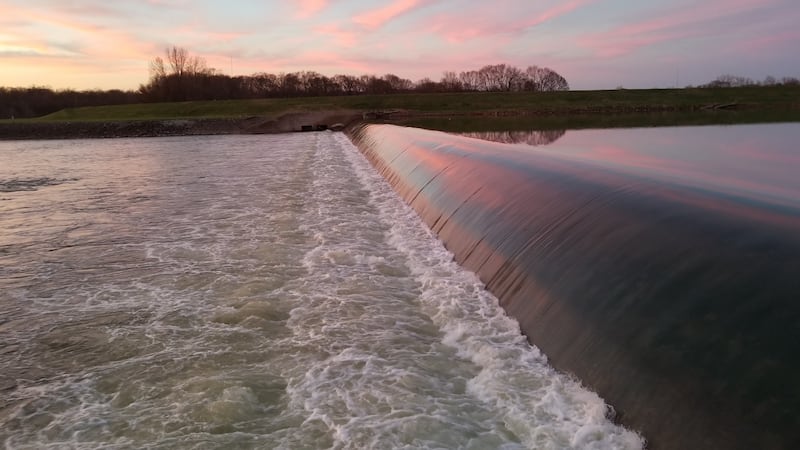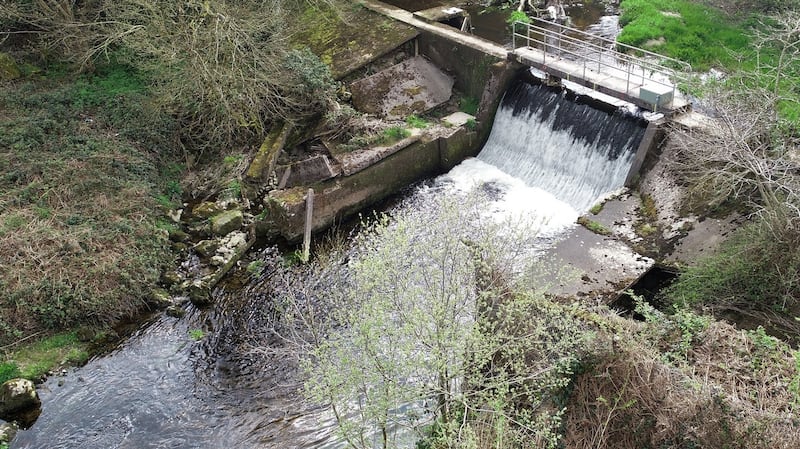To look at, the low-head dam that runs across the Great Miami River a short distance north of downtown Sidney in western Ohio is a stunning combination of natural beauty and human engineering. Water pours over its edge in a calm and constant motion. When the sun shines on it, the colours of the rainbow gleam across the water's glass-like form. It is one of perhaps tens of thousands such dams built across the United States in the early 20th century to manage waterways for a variety of reasons.
But it was here, in April 2020, that an engaged couple drowned after paddling over the benign-looking river barrier. The tragedy shocked the town, but such incidents are becoming increasingly common.
Flotation devices such as life jackets fail due to the large amount of oxygen bubbles present in the water countering their buoyancy
Here in the US heartland, concrete low-head dams are to be found on nearly every major river. Built mostly in the late-19th and early-20th centuries, they served as flood management devices for towns and cities as well as providing farmers with a consistent supply of water for irrigation.
They are dangerous because the hydrodynamics caused by the fast flow off the dam’s ledge result in water moving in a reverse motion upstream between the dam wall and the water “boil point” or back wash. Any human, animal or object unlucky enough to be caught in the circular current gets pushed under water, turned up and pushed back down again in an endless cycle. Flotation devices such as life jackets fail due to the large amount of oxygen bubbles present in the water countering their buoyancy.
Almost impossible to see by boaters and paddlers upstream due to their drop, low-head dams have been causing untold carnage, drowning hundreds of swimmers, paddlers and fishing enthusiasts across the US over the years. The Dock Street dam in Harrisburg, Pennsylvania, has drowned almost 30 people. Further west in Iowa, about 200 people have died after going over and getting into difficulty at low-head dams. Along with Minnesota, those two states are together responsible for one-third of all such drownings in the country, according to a 2015 study by researchers at Brigham Young University in Utah.
Now, as more people take to rivers and canals for recreation, especially in the coming months, and outdoor activities continue their popular run as the pandemic lingers, the threat posed by the dams – many having been long abandoned by their owners – is growing. Last April was proclaimed the first ever Public Safety at Low Head Dams month.
But a new effort in the US to locate and map dangerous dams is under way, mirroring a similar effort that's been developed in Ireland in recent years.
The authors of the Brigham Young University study are in the process of developing AI software that would find and identify all low-head dams around the country using Google Earth Pro.

"Through collaborative actions we are able to address issues that no one agency can handle. Although originally formed as a flood-based programme, our team focuses more on an all-hazards approach," says Manuela Johnson, who leads a taskforce called the Indiana Silver Jackets, which is collaborating with the US national dam database effort.
“We are made up of state, federal and regional agencies and organisations as well as higher education.”
The dams are a problem that affects many countries, Johnson adds. "It is a worldwide challenge which endangers our young men and women who enjoy the rivers and streams."
These dangers are increasingly prompting local and state authorities across the US into efforts to alter or entirely remove the structures.
Low-head dams present more than just a danger to human life. The dams have been particularly damaging to migrating fish and other river species that need to move up and down stream to breed, survive and thrive. In the US, organisations such as American Rivers have been backing river restoration efforts that have seen 69 dams removed in 2020 alone.
Dodder
In Ireland, efforts led by researchers at University College Dublin have been carving a similar path. Funded by the Environmental Protection Agency, the Reconnect initiative based in the university's school of biology and environmental science operated from 2016 to 2020, working to locate and map obstructions such as weirs and dams.

“Barriers associated with road-river crossings (eg culverts and fords) were most common and more evenly dispersed across the 10 study catchments. Second to road crossings were weirs, 117 in the Dodder alone. Many of the weirs are structures that were used for power generation for milling in the past,” says Dr Mary Kelly-Quinn, who served as Reconnect project co-ordinator.
“In addition to detailed mapping of barriers in 10 catchments, investigations of fish, macroinvertebrates, macrophytes, hydromorphology and eDNA were carried out in four core study areas on the Duag (Co Tipperary), Brown’s Beck Brook (Co Wicklow), Dalligan (Co Waterford) and Burren (Co Carlow) rivers, which each contained a significant barrier.”
The River Obstacles app, established by a group of UK-based environmental organisations, found that in July 2016-October 2017, 98 river obstacle record uploads were recorded across 16 counties in Ireland.
“The research included monitoring responses to removal of the ford on Brown’s Beck Brook. Specific investigations were carried out at 35 other locations across 12 river and stream systems,” Kelly-Quinn adds. A report detailing the results of the mapping and potential impacts on ecology and sediment dynamics will be published this spring (copies can be sourced at: mary.kelly-quinn@ucd.ie).
She adds it is estimated that there are at least 1.2 million in-stream barriers across Europe, 68 per cent of which are low-head structures.
Some members of the public oppose the removal of low-head dams since they attract visitors and tourists keen to observe and photograph the beautiful sight
While the Reconnect project focused on the effects to river-based flora and fauna, the presence of low-head dams and weirs has led to multiple drownings and near-death experiences across Ireland. In April 2010, two kayakers drowned after becoming trapped in a weir on the river Clodagh in Co Waterford.
Several months later, a kayaker attempting to paddle over the top of a weir on the river Bannon in Co Derry drowned when his Canadian canoe became trapped in the back wash. In August 2020, a man drowned while attempting to rescue his brother who had fallen into the river Lee at a low-head dam in Ballincollig, Co Cork, while fishing.
In the US, some members of the public oppose the removal of low-head dams since they attract visitors and tourists keen to observe and photograph the beautiful sight. Some anglers claim doing away with the dams would adversely affect their access to fish that gather in pools at the base of the dam, though research suggests that is not the case.
A growing number of communities are working to convert dams into safe river waves that can be used for surfing and as white-water drops for paddlers. Cities such as Dayton and Springfield in Ohio and Grand Rapids in Michigan have spent or are currently investing millions of dollars converting dangerous low-head dams into features that will attract water enthusiasts. In some instances, businesses such as surfing schools and stores selling kayaks and other water gear have sprung up in neighbourhoods surrounding the converted dams, adding to a sense of renewal around waterways that for decades had been either feared or ignored. It goes to show that behind every barrier lies an opportunity.









